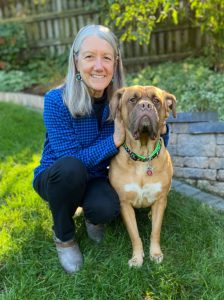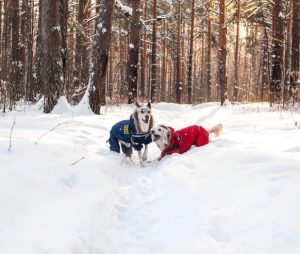
TERRY LACKMEYER
Customer Service Representative

Health Issues: Very old dogs and puppies can’t regulate their temperatures as well as other dogs and need special consideration. While these dogs can go outside in the frigid cold, keep their time outside limited and monitor them while they are out. Dogs with arthritis have a tough time traversing in snow and ice and are more prone to slipping and falling, which could lead to injuries such as a torn cruciate ligament. Dogs with heart disease, diabetes, Cushing’s, and Addison’s disease also have a difficult time regulating their body temperature and should be closely watched when outside for signs they are becoming uncomfortable.
Hair Types: Dogs with short hair are going to get cold much faster than a long-haired or double-coated dog. Consider getting a coat or sweater for your short-haired dog, especially if they are thin-skinned like a greyhound. Forgo shaving down your long-haired or double-coated dog during the winter as the extra hair acts as insulation to help keep them warm. If you’re worried about the snow or salt clinging to the longer hair, simply trim those long feathers shorter on the front and back legs.
Wardrobe: If your dog still wants to take those long walks, consider getting them a coat or sweater. If you live in a particularly cold climate, even a long-haired or double-coated dog would benefit from protective outerwear.
There are many styles of coats on the market, ranging from sweaters with sleeves for the front legs to coats without sleeves that cover the body and shoulder area and strap under the belly. Many are made with waterproof fabric and have sheepskin or fleece lining. The most important thing is that the sweater or coat fits your dog well and enables them to move freely and comfortably.
It is important too, to check to make sure your dog will be able to urinate and defecate without soiling the garment. It is also a good idea to have more than one sweater or coat for your dog so that the garment is always dry when you put it on your dog. Putting a cold wet garment on your dog will feel very uncomfortable to them and increase the chance of hypothermia.
Boots will protect your dog while out walking. They will protect your pooch from salt chemicals coming in contact with their paws and keep snow and ice from building up between their paw pads. If your dog doesn’t like wearing boots, try putting a protective layer of petroleum jelly on their paws before heading out. There also are commercially available products to help protect your dog’s paws. Check with your local pet store or online for these products.
Identification: Be sure your dog is wearing identification tags on their collar whenever they go outside. Snow changes the appearance of the environment and covers scents on the ground. Should your dog get loose, they will have a much harder time finding their way home on their own, and the tag will enable someone to contact you should they find your dog.
Walking Routes: When walking your dog, try to stay on streets and sidewalks that are plowed or shoveled. If walking through snow covered areas, check your dog’s paws frequently to be sure snow and ice are not collecting between the pads of their paws. Avoid walking over streams or ponds as there is no way of knowing how thick the ice is or if it will support the weight of you and your dog. Better not to take the chance of falling through and having both of you become hypothermic or worse.
Outdoor Housing: If your dog must be outside for prolonged periods of time, be sure they have adequate protection from the elements. Their shelter should be raised up off the ground and bedding should be thick and dry. Be sure to change the bedding regularly to keep it clean. Always make sure the dog has access to clean, fresh, unfrozen water. Finally, be sure the door of the shelter does not face into the wind and has a protective flap covering the entrance.
Vehicles: We all know not to leave our pets in a car during hot weather, but similar precautions should be taken during extreme cold as well. Prolonged exposure in a cold, unheated car can cause hypothermia in your pet. Best to leave your pet at home if they are to remain unattended in the car for any length of time.
The warm engines of parked vehicles are a draw for outdoor and feral cats. Be sure to check under your car, bang on the hood, or honk your horn before starting your vehicle. You don’t want an unsuspecting kitty trapped in your engine as you drive away.
Signs of Overexposure: While out and about, be alert for signs that your dog may be getting too cold. If they appear anxious, whiny, weak, slows down, or tries to burrow in snow or they keep lifting their paws and shaking them, get inside quickly. These behaviors are all signs that the cold is bothering them, and they need to get warmer.
Sleeping Spots Inside: Check the location of your dog’s bed inside the house during the cold months and make sure the location is not drafty or on a cold floor. If so, temporarily relocate the pet’s bed. This is particularly true for elderly or arthritic pets or those with chronic health conditions that would make them more susceptible to unpleasant temperature changes.
Diet: Keep in mind if your dog is spending a lot of time outdoors, they will be burning more calories. If that is the case, giving them a little extra food may be in order. Just take care not to overfeed, you want your dog to maintain their weight during the cold weather, not add extra pounds.
Most dogs love being outside in the snow, and they love it even more when you go out and play with them. Face it, exercise is good for all of us. Just keep in mind if it is too cold for you to be out for any length of time, it is probably too cold for your dog as well. Keeping these suggestions in mind will keep both you and your dog safe during those frigid months and help both of you to live happier, healthier lives.
